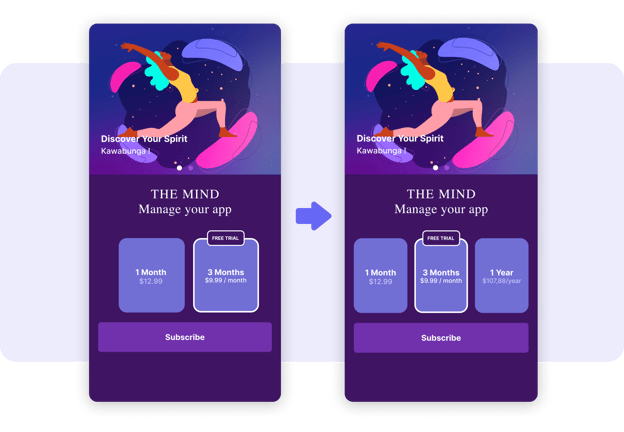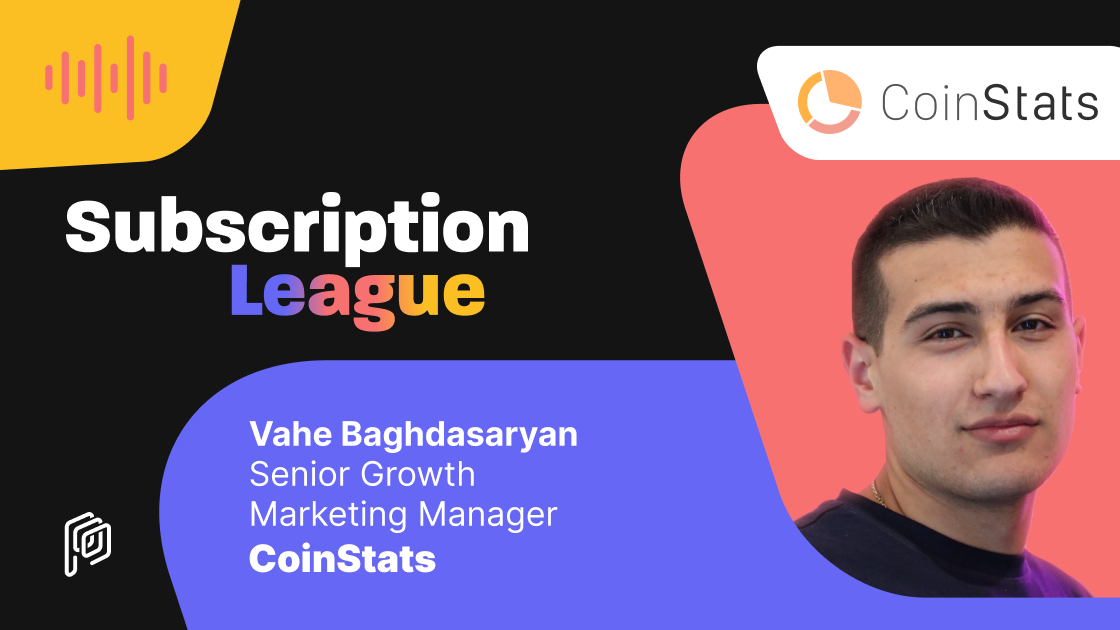Just how much should your subscribers pay? In this episode of Subscription League, we delve into the delicate balance between maximizing app revenue and ensuring subscriber satisfaction with the help of Vahe Baghdasaryan, a 5-star Growth Marketing Mentor and Senior Growth Marketing Manager at CoinStats. Join us as we explore the recommendations and insights from Vahe on the ideal pricing strategies and monetization models for subscription apps.
Subscription Optimization: Paywall optimization is just the tip of the iceberg
When it comes to growth, there's always room to soar higher. And during our chat with Vahe, the topic of subscription optimization took center stage. Vahe offered a fresh perspective, reminding us that paywall optimization is only one piece of the monetization puzzle. The real key to success, he says, lies in truly understanding app users and the problems they're trying to solve in the app and its premium features.
Too often, product teams overlook this crucial step and end up making monetization decisions in the dark. This leads to a mismatched model that fails to resonate with users, resulting in poor revenue performance. But at CoinStats, they took a different approach. They didn't just focus on paywall optimization but delved deep into the needs and desires of their customers. And as a result, they discovered the value in other monetization tactics, such as the banded model, feature valuing, and understanding users’ willingness to pay.
Read on to learn more about the different monetization tactics.
CoinStats' Approach to Monetization #1- The banded model
The banded model for subscription app monetization refers to a pricing strategy where the app offers multiple subscription tiers with different levels of features and benefits, at different price points. This approach is commonly used by B2C companies like CoinStats, whose goal is to cater to a wider range of users with different needs and budgets.
For example, the app might offer a basic tier with limited features for a lower price, and a premium tier with more features and perks for a higher price. By offering different subscription options, the app can monetize more effectively, as users are more likely to choose a tier that best matches their needs and budget. Additionally, the app can also generate more revenue from users who are willing to pay more for extra features.
CoinStats' Approach to Monetization #2- Valuing features
It's important to understand that not all features are valued equally by all users. Different use cases value different features in different ways. For example, one use case may value feature X more while another use case may value feature Y more.
To understand these differences, ConiStats uses Max-Diff analysis.
Max-Diff, short for Maximum Difference scaling, is a research methodology used in feature benefit analysis to understand what features your customers value the most. The principle behind Max-Diff is simple - customers are presented with a list of features and are asked to choose the most important and the least important among them. This process is repeated multiple times, and the results are analyzed to determine the most valuable features.
The information gathered from Max-Diff analysis can be used in several ways to improve in-app product offerings and marketing strategies.
-
Apps can use the most valued features to highlight them on their paywalls and pricing pages.
-
It can also help subscription apps understand what to include and what not to include in their premium offering and drive revenue for the app.
CoinStats' Approach to Monetization #3 - Understanding the willingness to pay
When it comes to monetizing a subscription app, it's important to understand the customers' willingness to pay. This willingness can vary greatly depending on the product, features, and use case, so it's crucial to take this into consideration before moving forward. During the talk, Vahe dives into the idea of the drop principle, one of the commonly used product pricing strategies in the world of subscription apps.
The idea behind the drop principle, also known as the decoy effect, is to present consumers with a limited number of options, one of which is a "decoy" option that is designed to make a more appealing option appear more attractive.
For example, an app might offer a monthly subscription plan at a relatively high price, a quarterly subscription plan at a slightly lower price, and a yearly subscription plan at an even lower price. The yearly plan would be the "decoy" option, as it is designed to make the quarterly plan appear more attractive by comparison. By presenting consumers with the yearly plan, the company is hoping to steer them towards choosing the slightly less expensive quarterly plan, which offers a higher profit margin for the company.

An example of pricing optimization based on the drop principle: By presenting the decoy option (the Yearly plan), the app can influence users' perception of value and steer them toward the option that is most favorable for the app’s revenue.
The drop principle works by exploiting consumers' tendency to make relative comparisons when making purchasing decisions. When faced with multiple options, consumers are likely to compare the options to one another and make their decisions based on the relative value of each option. By presenting the decoy option, the app can influence users' perception of value and steer them toward the option that is most favorable for the app’s revenue.
Overall, not only the strategy helps apps to determine the optimal pricing point, but also helps understand how to discount their In-App Products by using the lower bound prices as a discount offer. Apps can also vary the approach based on factors such as country, operating system, or user location.
Price Experimentation - Big Testing for Big Results
When CoinStats started experimenting with pricing, they decided to go for a big testing approach. Instead of testing the difference between two close prices, such as 41.99 versus 44.99, they tested the difference between 41.99 and 119.99. The result of two-month testing was surprising, as they found that twice as many customers signed up for the higher-priced package of 119.99 compared to 41.99.
According to Vahe, several factors played a role in the success of the higher-priced package.
1) Most of their competitors had more expensive packages, so a price of 119.99 did not seem unreasonable.
2) The lower price of 41.99 placed the product in the "cheap" category, which made customers suspicious of the quality of the product.
3) The target audience for the product was traders and investors who had a higher willingness to pay for a good service.
While it is tempting to price a product low to attract more customers, the approach may not always lead to better revenue. The experience of CoinStats reminds us that it is important to consider all factors when setting the subscription price and to experiment with different pricing strategies to find what works best.
Price Experimentation - The impact of subscription length
Building the right subscription monetization model requires careful consideration of various factors, one of which is subscription length.
The popularity of monthly and yearly subscriptions is well known, but lifetime subscriptions can also be a highly effective tool for generating revenue and attracting a dedicated customer base.
CoinStats found success in offering both annual and lifetime subscriptions. The annual option was their most popular, which they actively promoted, while lifetime subscriptions were five times the price and appealed to their most passionate customers. To their surprise, some enthusiastic users with higher purchase intent preferred the lifetime option over the more traditional monthly or annual options.
Through their experiences, CoinStats has discovered the value of experimenting with different subscription lengths to tap into the app usage preferences of each user niche. This can lead to greater revenue opportunities for the app.
Price experimentation - Location-based pricing
CoinStats has adopted a location-based pricing model in order to optimize pricing for regions with different levels of purchasing power. According to Vahe, the company's revenue came primarily from the United States, Canada, and northern Europe before the switch to the location-based model.
Benefits of location-based pricing
The company divided locations into five groups based on revenue analysis and then conducted a one-way analysis to determine the willingness to pay per region.
The location-based pricing has proven to be effective for CoinStats, as it has increased revenue from regions such as Eastern Europe. The company recognizes that implementing this model requires a significant investment in infrastructure to manage and analyze the experiments.
Currently, CoinStats only offers different prices per region(location group) but may consider diving deeper into this approach in the future if they see potential in a particular location.
Price Testing vs. Price Discrimination
When it comes to price testing and price discrimination, it is important to be aware of local legislation. According to Vahe, it is important to look at the local legislation in the area where you plan to implement price discrimination or pricing testing.
In the European Union, price discrimination is allowed under certain conditions. Price differences for the same service can be justified if they're based on objective criteria. But price discrimination based on nationality or country of resilience is forbidden.
In addition, it is common for companies to have different prices on mobile and web, as it helps users convert to the web and avoids the commission fees charged by app stores. However, this can break app store laws if the product is sold at a different price on mobile and web platforms.
Price testing with Purchasely is easy - learn it today!
Maximize your in-app revenue with Purchasely's price testing feature! Experiment with new subscription offers to gauge your market's appetite, measure the responsiveness of demand with ease, and personalize your pricing offers to suit every country or user segment with precision. All this, without any coding required and in just a few clicks!

Learn more about the Purchasely price testing feature here.
Episode 19 Sneak Peek
On understanding customers
“We started with the most early stages of the monetization model to understand what are the use cases of our customers, and what are the problems that they are trying to solve with our product and also with our premium features. ”
On valuing features
“The interesting thing is that people tend to think that all the features are created equal, but it's not. And all your users valued the same feature in the same way. But in the end of the day, you have multiple use cases, and each use case value their features differently.”
On the willingness to pay
“if you are a company that is working with a premium model, you should understand what to put in a premium model and what to put in the premium plan. This help you to understand the position of your product or your features and use the best ones in promoting your premium plan and the least ones in your premium plan or other places.”
On pricing experiment experience
“we end up doing this big A-B testings 41.99 versus 119.99. And as a result of more than two months of testing, we end up getting twice more customers signing for 119.99 than 41.99”
“The other thing is when you price your product low, people tend to see these pricing in the spectrum. They see if your product is 41.99, they start to compare it with other product that it's in the spectrum. Unfortunately, these days, there are a lot of apps there that are trying to do their position themselves as cheap.”
“When we were adopted this location-based pricing and put a price there that it's more convenient people to use, they end up paying more. So if before we're getting the 1% of our revenue from Eastern Europe, now we're getting 2% of the revenue, 3% of the revenue from this year. So location-based pricing becomes heavy when you scale it.”

More about Vahe
Vahe Baghdasaryan is a highly accomplished growth product and marketing professional with a wealth of experience in consumer startups across various industries, including Education and Fintech. He currently holds the position of Senior Growth Marketing Manager at CoinStats, where he is responsible for driving subscription optimization, user retention, and activation and leads the lifecycle marketing team.
He has spoken internationally on engagement strategies, user activation, and onboarding optimization strategies. Check his talk at App Promotion Summit Berlin 2022 - Leveraging Behavioural Science in Onboarding and Lifecycle Marketing.
He’s also a 5-star rating mentor on GrowthMentor. Vahe has recently released his on-demand courses on subscription optimization & pricing strategy. More information can be found here.
Episode Topics at a Glance
-
CoinStats’ approach to monetization
-
Why understanding customers is important
-
What is a banded model in subscription pricing
-
How to value subscription features
-
How to measure the willingness to pay
-
The drop principle - a commonly used product pricing strategies
-
Price Experimentation - Big Testing for Big Results
-
The impact of subscription length
-
Location-based pricing
How to listen to Subscription League
Go to SubscriptionLeague.com or subscribe to our podcast on Apple Podcasts, Google Podcasts, Spotify, Podcast Addict, Amazon Music, or wherever you listen to your podcasts.
HAPPY LISTENING!
.png)
.png)





